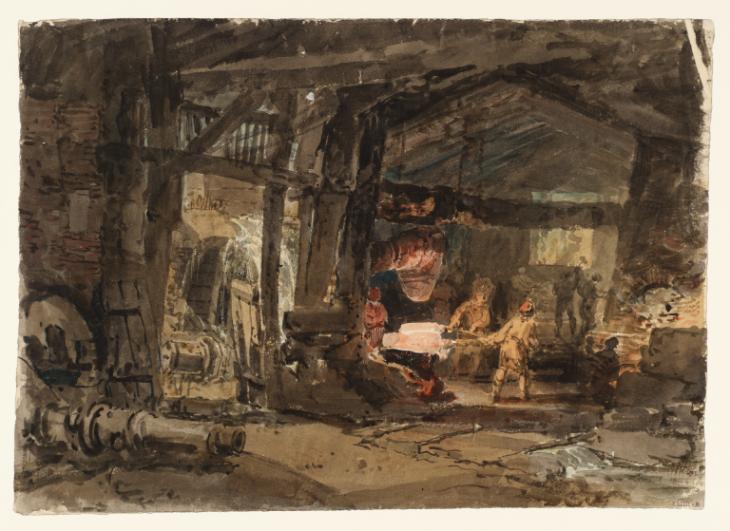Joseph Mallord William Turner The Interior of a Cannon Foundry 1797-8
Joseph Mallord William Turner,
The Interior of a Cannon Foundry
1797-8
Joseph Mallord William Turner 1775–1851
The Interior of a Cannon Foundry 1797–8
D00873
Turner Bequest XXXIII B
Turner Bequest XXXIII B
Pencil and watercolour with some scratching-out on white wove paper, 247 x 347 mm
Stamped in black ‘XXXIII – B’ bottom right
Stamped in black ‘XXXIII – B’ bottom right
Exhibition history
1968
Art and the Industrial Revolution, Manchester City Art Gallery, May–July 1968 (269).
1996
Turner in the North of England, 1797, Tate Gallery, London, October 1996–February 1997, Harewood House, Leeds, March–June 1997 (3).
References
1909
A.J. Finberg, A Complete Inventory of the Drawings of the Turner Bequest, London 1909, vol.I, p.65, XXXII B, as ‘An Iron Foundry’. c.1796–7.
1968
Elizabeth Johnson, Art and the Industrial Revolution, exhibition catalogue, Manchester City Art Gallery 1968, p.79 no.269.
1988
Anne Lyles, Young Turner: Early Work to 1800: Watercolours and Drawings from the Turner Bequest 1787–1800, exhibition catalogue, Tate Gallery, London [1988] 1989, p.34.
1993
Joyce Townsend, Turner’s Painting Techniques, exhibition catalogue, Tate Gallery, London 1993, p.41, 40 fig.32 (colour).
1996
David Hill, Turner in the North: A Tour through Derbyshire, Yorkshire, Durham, Northumberland, the Scottish Borders, the Lake District, Lancashire and Lincolnshire in the Year 1797, New Haven and London 1996, p.16, pl.13 (colour).
2009
Celina Fox, The Arts of Industry in the Age of Enlightenment, New Haven and London 2009, p.443, fig.225 (colour).
Technique and condition
In this watercolour painting on off-white wove Whatman paper, graphite pencil drawing is visible in areas of thin paint application. Dense, even washes were then used. These have been darkened with black washes, but never mixed directly with black. This is an early example of Turner’s use of Mars orange, a fine-grained, synthetic earth pigment of a brighter colour than any of the natural earth pigments. He used it throughout his life, often as a light wash to intensify another colour. Here he has also used local areas of it to dramatic effect, for the water-hammer, the large ingots of metal under the hammer, and parts of the costumes, which are of course illuminated by the red-hot metal.
The ingots themselves are painted in this intensely coloured pigment over an area of reserved white paper, to create a brilliant contrast with the brown- and grey-washed paper everywhere else, painted with a limited number of brown earth pigments and possibly a brown madder. Deep blue washes in the shadows above the ingots further enhance their glow, through the use of opposed cool and warm colours. This may well be an early use of Prussian blue, for Turner. The channel of water run off from the water-wheel, and emerging in the right foreground as a water supply for quenching the metal, is painted into a reserved white area too, but with more neutrally-tinted washes, to create a more muted highlight that does not eclipse the glowing metal.
The white spray from the water-wheel was created by scratching into the paint with a thick pin, or quite possibly Turner’s sharpened thumb-nail, which he was reputed to use for the purpose, and whose right-handed scratches can be recognised in a number of oil paintings. The spray is accurately depicted descending in curved lines, and for this he would have had to turn the paper upside-down for some of the scratches, if he always used his right hand for the task. This is not as surprising as it sounds: most right-handed artists use that hand for everything, and Turner was also reported to be able to correct and improve engravers’ proofs when they were upside-down. (Left-handed artists are more likely to work with both hands, to transfer a brush or other tool to the hand nearest to the mark about be made, and to avoid reaching across themselves.)
Helen Evans
October 2008
Revised by Joyce Townsend
February 2011
How to cite
Helen Evans, 'Technique and Condition', October 2008, revised by Joyce Townsend, February 2011, in Andrew Wilton, ‘The Interior of a Cannon Foundry 1797–8 by Joseph Mallord William Turner’, catalogue entry, January 2013, in David Blayney Brown (ed.), J.M.W. Turner: Sketchbooks, Drawings and Watercolours, Tate Research Publication, November 2014, https://wwwThis is apparently based on a page in the North of England sketchbook (Tate D01001; Turner Bequest XXXIV 90). When it was exhibited at Manchester in 1968 the drawing was tentatively identified as Woolwich Arsenal,1 but on the strength of the association with the North of England tour Hill has proposed that it shows one of Walker’s foundries, either at Rotherham or Conisbrough. The curator and historian Celina Fox, however, calls the sheet ‘Ironworks, Merthyr’, relating it to the work Turner did for Anthony Bacon at Merthyr Tydfil in 1798; see the Cyfarthfa sketchbook (Tate; Turner Bequest XLI).
Verso:
Blank; some paint smears; inscribed in a later hand: ‘22’; stamped in brown ink with Turner Bequest monogram.
Andrew Wilton
January 2013
How to cite
Andrew Wilton, ‘The Interior of a Cannon Foundry 1797–8 by Joseph Mallord William Turner’, catalogue entry, January 2013, in David Blayney Brown (ed.), J.M.W. Turner: Sketchbooks, Drawings and Watercolours, Tate Research Publication, November 2014, https://www

